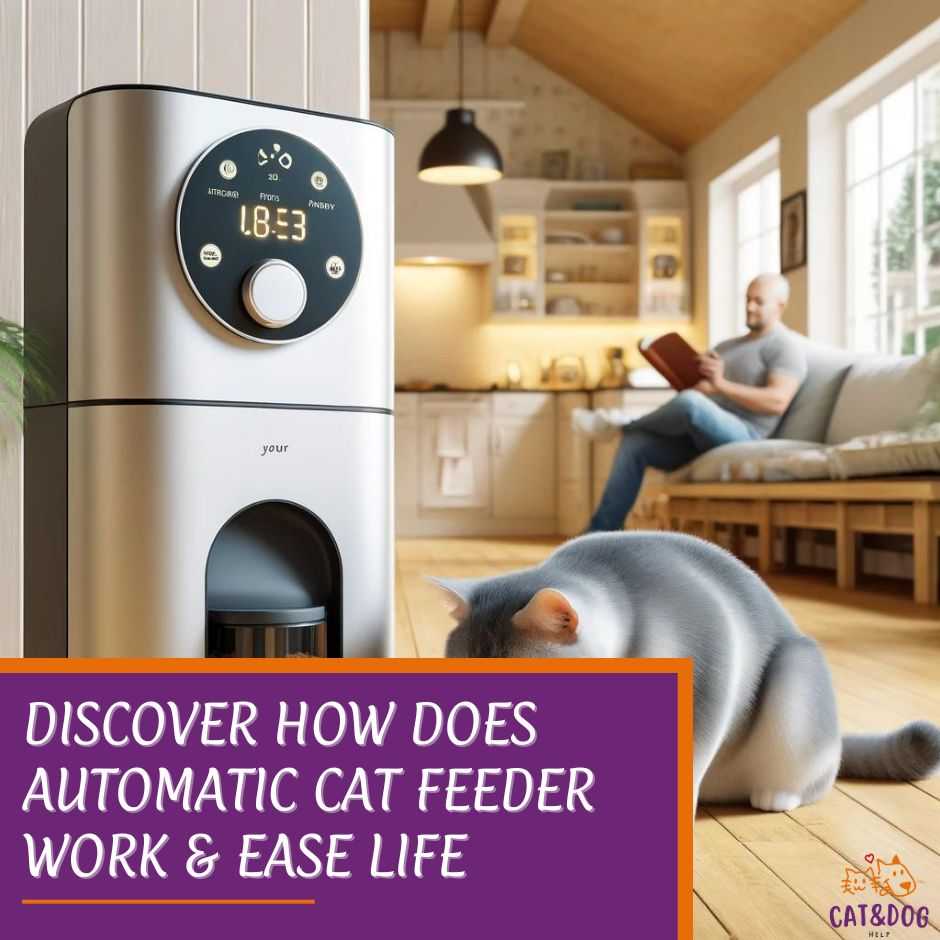Ever wondered how your furry friend can maintain a regular feeding schedule even when you’re not home? Automatic cat feeders are here to save the day!
These handy devices allow you to provide consistent meals for your cat, whether you’re caught up at work or away for the weekend.
They’re designed to dispense food at preset times and quantities, so you can rest easy knowing your cat won’t go hungry or overeat.
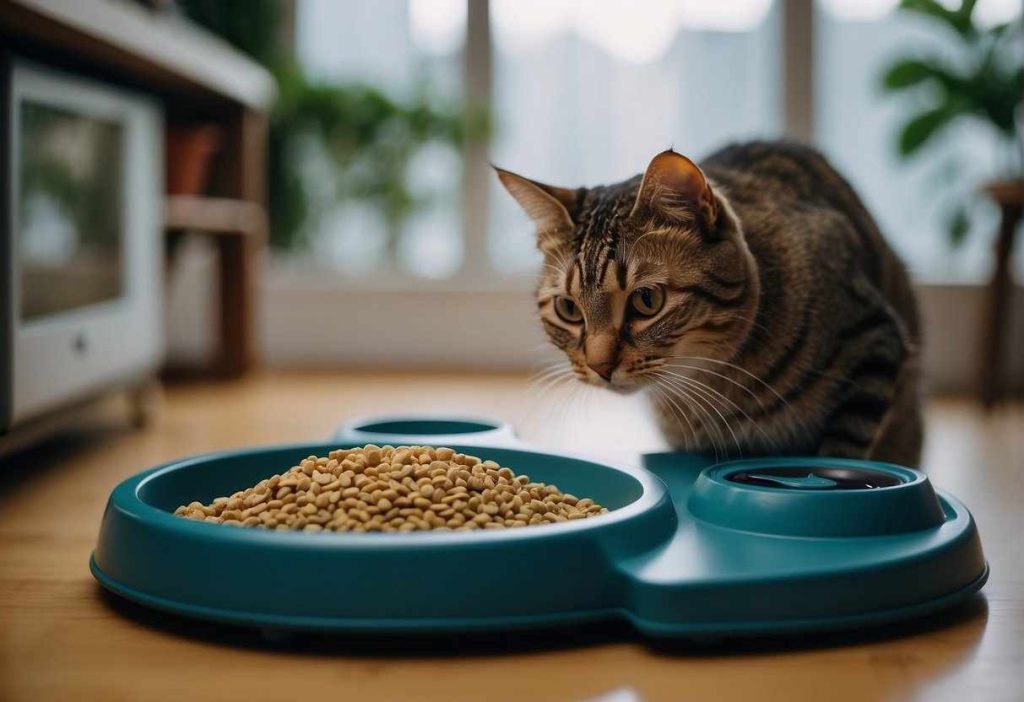
But, how does an automatic cat feeder work? Setting up your automatic cat feeder is relatively straightforward.
By choosing the right type for your cat’s needs, you can address common pet feeding challenges, from overeating to demanding food outside scheduled meal times.
With advancements in technology, many feeders can now be integrated with other pet care apps, so you can keep track of your cat’s diet alongside their other activities.
Key Takeaways
- Automatic cat feeders ensure meals are given on time.
- The setup is simple and can help control pet feeding issues.
- They can be part of a broader smart pet care system.
Understanding How Does Automatic Cat Feeder Work
The Basic Mechanisms Explained
At its core, an automatic cat feeder is designed to dispense cat food at pre-set times. They come equipped with:
- A hopper: which stores the food.
- A feeding bowl: where your cat eats.
- Dispensing mechanisms: these could be a rotating auger or a simple slide that moves to release food.
Here’s a quick rundown:
- Programmed via buttons or a touchscreen, you decide when and how much food is released.
- At the designated time, the feeder triggers its mechanism.
- A precise portion of kibble glides into the bowl, all without you lifting a finger!
Insights into the technology ensuring timely feeding and portion control: These smart devices often utilize digital timers and scales to provide the exact amount of food needed for your cat’s dietary needs.
Advanced Features Enhancing Pet Care
Apart from just feeding, these neat helpers come with bells and whistles for the 21st-century pet owner:
- Wi-Fi Connectivity and App Functions: Control your pet’s diet from your smartphone, anywhere, any time.
- Voice Recording: Personalize the feeding experience by recording a message to call your cat to eat, adding comfort to their routine.
The role of voice recording features in comforting pets: Imagine your voice soothing your cat even when you’re miles away! It’s like leaving a bit of your presence at home.
Controller Table
| Function | Description |
|---|---|
| Timer | Sets feeding schedule |
| Portion Adjustment | Controls the amount of food |
| Voice Recorder | Records personal messages |
| Wi-Fi/ App Control | Manages feeder settings remotely |
With these systems in place, managing your cat’s feeding patterns becomes an enjoyable and stress-free task.
Remember you’re not just filling a bowl, you’re ensuring a healthy, happy cat with the wonders of modern technology. Now, isn’t that a comforting thought?
Setting Up Your Automatic Cat Feeder
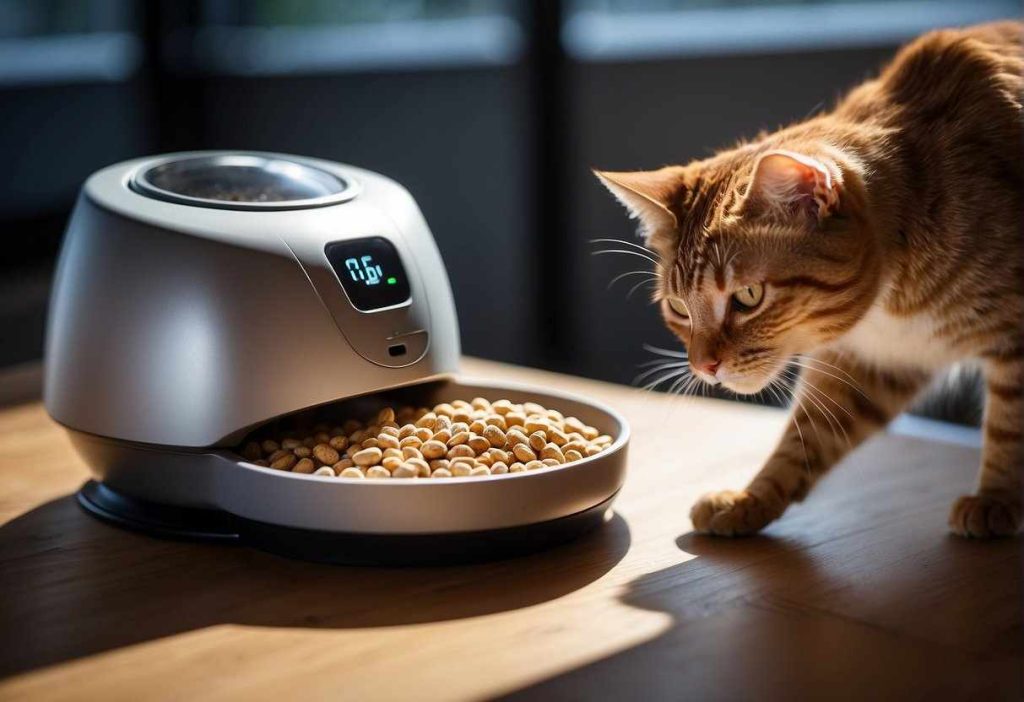
What you’ll need:
- Automatic cat feeder
- The power source (batteries or power cord)
- Cat food
- Measuring cup
First things first, locate a spot for your feeder that’s easy for your cat to access but not in the pathway of heavy foot traffic – you don’t want any accidental kicks to the feeder!
Once you have the perfect spot, follow these steps:
- Power Up: Insert the batteries or plug in the power cord. A little light or beep usually signals it’s on duty.
- Fill ‘Er Up Open the food compartment and pour in the cat food using the measuring cup. Check the maximum capacity to avoid overfilling.
- Programming Time: Here’s where you can get techy! Use the interface to set feeding times and portions. Most feeders allow multiple daily feedings; just follow the on-screen prompts or buttons. (1)
- Test Run: Before leaving it to its devices, do a manual feed to see it in action. Make sure the food is dispensed correctly.
Don’t forget to keep your feeder clean – a regular rinse-out of the food compartment and a wipe-down of the exterior will fend off germs.
If you bump into issues, most brands provide a troubleshooting guide in their manual.
For upkeep, keep an ear out for unusual noises or look for erratic feeding – signs it may need a checkup. Regular users often note less stress about feeding times and a happy, well-fed cat.
Remember, each machine is unique, so it’s wise to read the user manual for specific instructions tailored to your model. And with these tips, mealtime becomes a breeze—your cat will thank you!
Types of Automatic Cat Feeders Explored
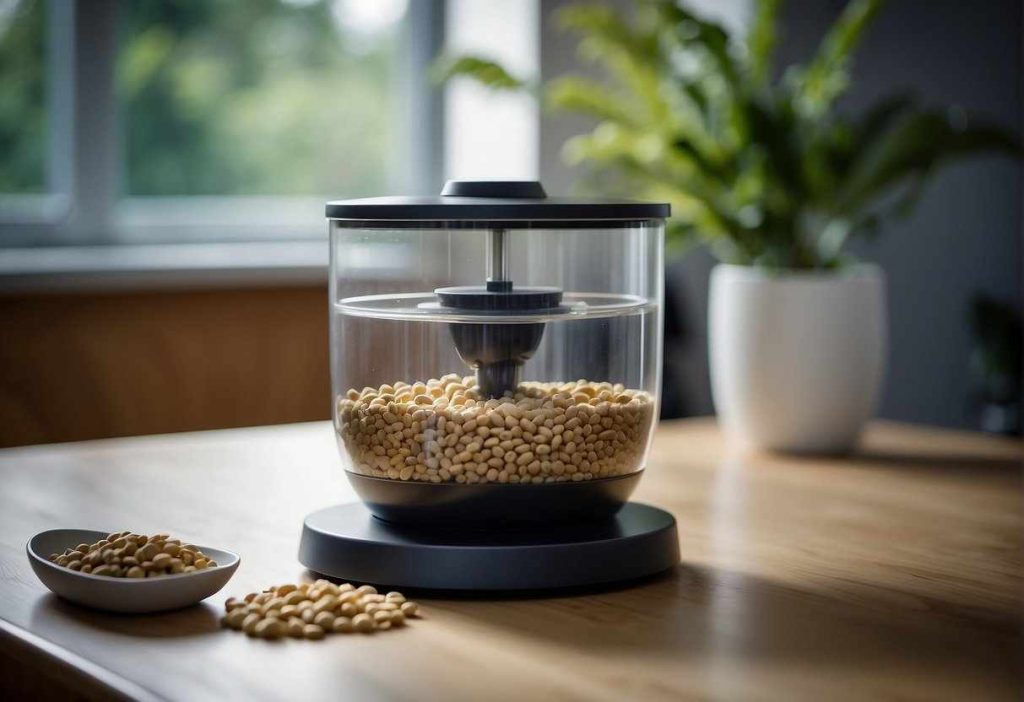
Gravity Feeders: The old faithful of cat feeders. No frills here, just a simple container that uses gravity to refill the bowl as your cat munches away. Great for cats who don’t overeat, but a no-go if yours is a little glutton.
- Pros: Simple, no power required.
- Cons: No portion control.
Electronic Feeders: These are the control freaks in the feeder world. You set the time and amount, and it dispenses meals like clockwork. Perfect if your kitty is on a strict diet.
- Pros: Timed meals, and portion control.
- Cons: Requires power source, mechanical parts can break.
Smart Feeders: The tech-savvy pet parent’s dream!
Controlled by your smartphone, these feeders offer the most customization for feeding schedules and portion sizes. They can even send you notifications when your cat is fed. (2)
- Pros: High customization, and remote access.
- Cons: Pricier, Wi-Fi dependent.
| Feeder Type | Pros | Cons |
|---|---|---|
| Gravity | No power needed, easy to use | No portion control |
| Electronic | Timed portions, useful for diets | Needs power, possible mechanical issues |
| Smart | Custom schedules, notifications, remote access | More expensive, requires Wi-Fi |
Now, which should you choose? Consider your lifestyle and your cat’s eating habits. Are you often away from home? Maybe the smart feeder is your match.
Budget-conscious and have a self-regulating cat? A gravity feeder might just be enough. The bottom line—your choice should suit both your needs and your cat’s health!
And remember, while feeders are convenient, they’re not substitutes for your love and attention.
The Impact of Automatic Feeders on Pet Health and Diet
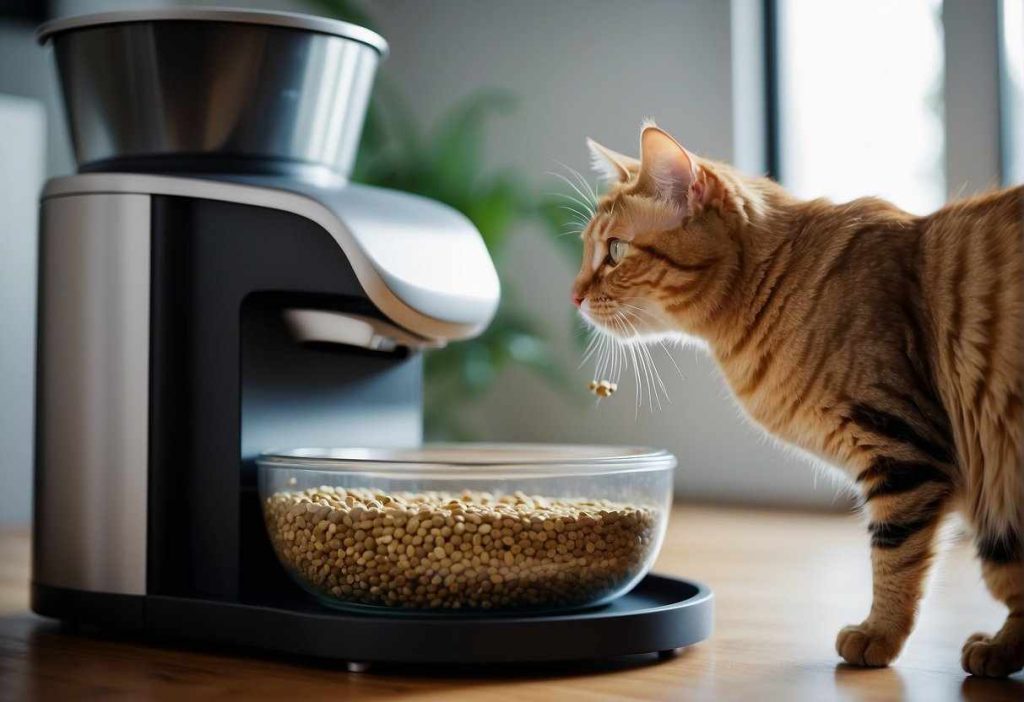
Promoting Healthy Eating Habits
With automatic feeders, you’re in control of how much and how often your cat eats. It’s like having a personal pet dietitian!
Obesity in pets can lead to all sorts of health issues, but with pre-measured meals served on a regular schedule:
- Your pal is less likely to overeat. (3)
- Weight can be managed effectively.
- The risk of diabetes and joint problems may decrease. (4)
Diet Management for Medical Conditions
If your kitty has a medical condition, such as diabetes, feeding time is crucial. Here’s where veterinarians often give two paws up for automatic feeders.
By dispensing meals at consistent times, feeders help maintain stable blood sugar levels, which can be vital for a diabetic cat’s health.
Feeder Features and Considerations
While automatic feeders are beneficial, they aren’t all created equal. Consider the following features for optimal health benefits:
- Programmable timers
- Portion control settings
- Ability to handle a range of food types
Choosing a feeder isn’t just about convenience; it’s about maintaining your cat’s health. Remember to clean feeders regularly to prevent bacteria build-up, and always ensure fresh water is available.
Go on, take the leap! Your cat might just thank you with a satisfying purr after a perfectly portioned meal.
Addressing Common Pet Feeding Challenges
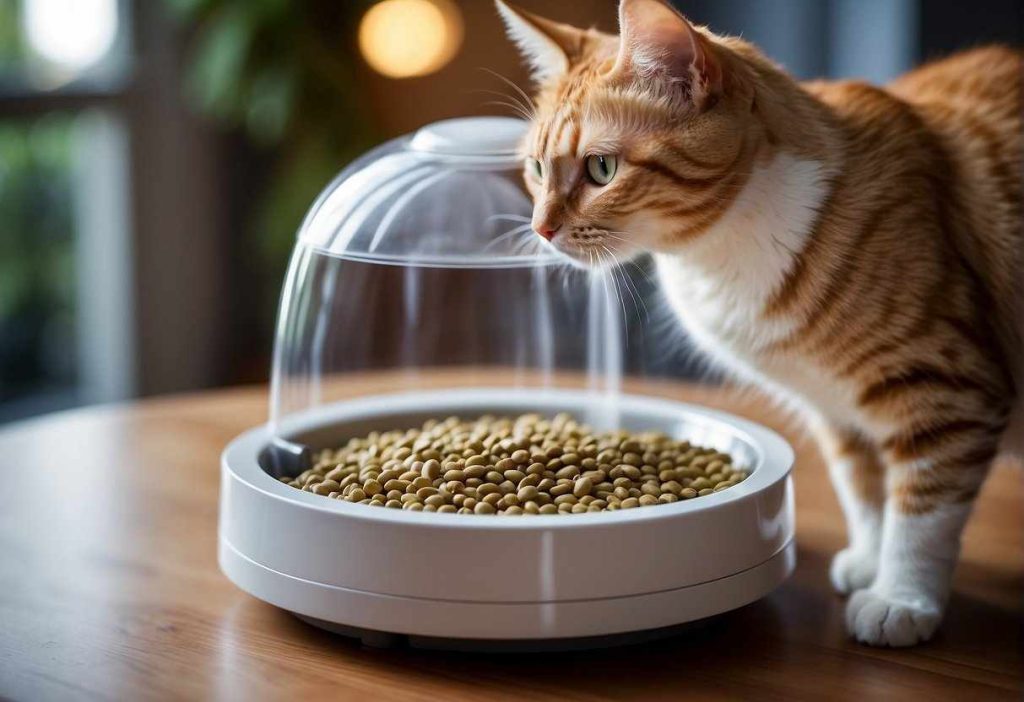
Solutions for Early Morning Wake-Up Calls and Overeating:
- Set it and forget it: Program your automatic feeder to dispense food at set times, preventing those piercing 5 AM wake-up calls.
- Portion perfection: By controlling how much food is dispensed, you ensure your buddy isn’t overeating.
How automatic feeders can help regulate feeding times and amounts:
- Consistency is key: Regular feeding times help regulate your pet’s hunger and digestion.
- Portion control: You can specify the exact amount to be dispensed, tailoring it to your pet’s dietary needs.
Mitigating Food Aggression Among Multiple Pets:
- Feeding in harmony: Multiple feed settings allow for different feeding schedules, reducing competition and aggression. (5)
- Personal space: Separate feeding areas created by individual feeders give each pet their own dining spot.
Using feeders to manage feeding in multi-pet households:
- Peaceful meals: Automatic feeders can be programmed for multiple pets, making sure everyone gets their fair share without any fuss.
- Easy tracking: Keep tabs on who’s eating what and how much, simplifying your life and diet monitoring.
Integrating Automatic Feeders with Other Pet Care Technologies
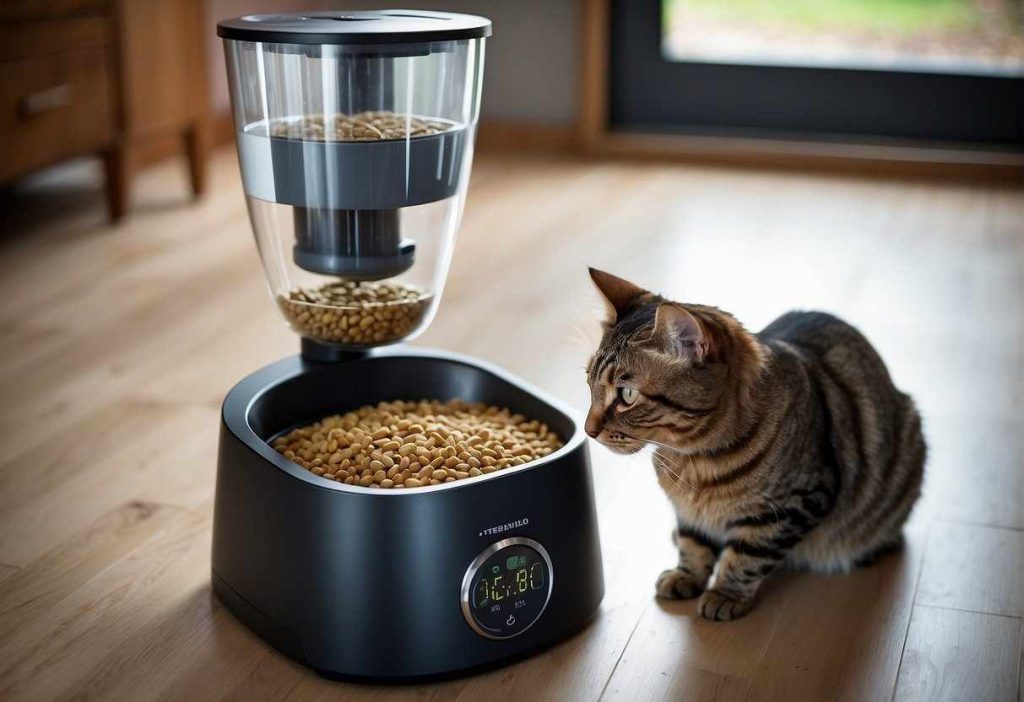
1. Smart Water Fountains:
- Consistent Hydration: A smart water fountain can sync with your feeder to ensure your cat stays hydrated after meals.
- Filter Alerts: Some fountains send notifications to change filters, keeping H2O fresh for your pal.
2. Pet Cameras:
- Ever miss your kitty while you’re away?
- Meal Monitoring: Watch your cat dine in real-time or review feeding footage to confirm meals are eaten. (6)
- Interactive Features: Some models allow for two-way audio, or dispensing treats—hello, midday snack!
3. Health Monitors:
- Activity Tracking: Devices that track your cat’s activity levels can coordinate with feeding schedules.
- Health Alerts: Immediate updates on changes in eating habits can signal health issues early on.
Quick Tips:
- Seamless Schedules: Combine feeder and exercise data to fine-tune meal portions.
- Remote Access: Control and monitor all devices via a single app.
Integration Advantages:
- Simplified Monitoring: Keep tabs on various aspects of pet care through one interface.
- Consistency and Routine: Automated technologies ensure regular feeding and activity intervals.
- Peace of Mind: Knowing your cat’s care is interconnected and easily manageable, even when you’re not home.
A fully integrated pet tech ecosystem not only nurtures your cat’s physical health—you also get a window into their world, which strengthens your bond.
Plus, it’s pretty cool to have a high-tech buddy caring for your whiskered companion, wouldn’t you say?
Quick Recap
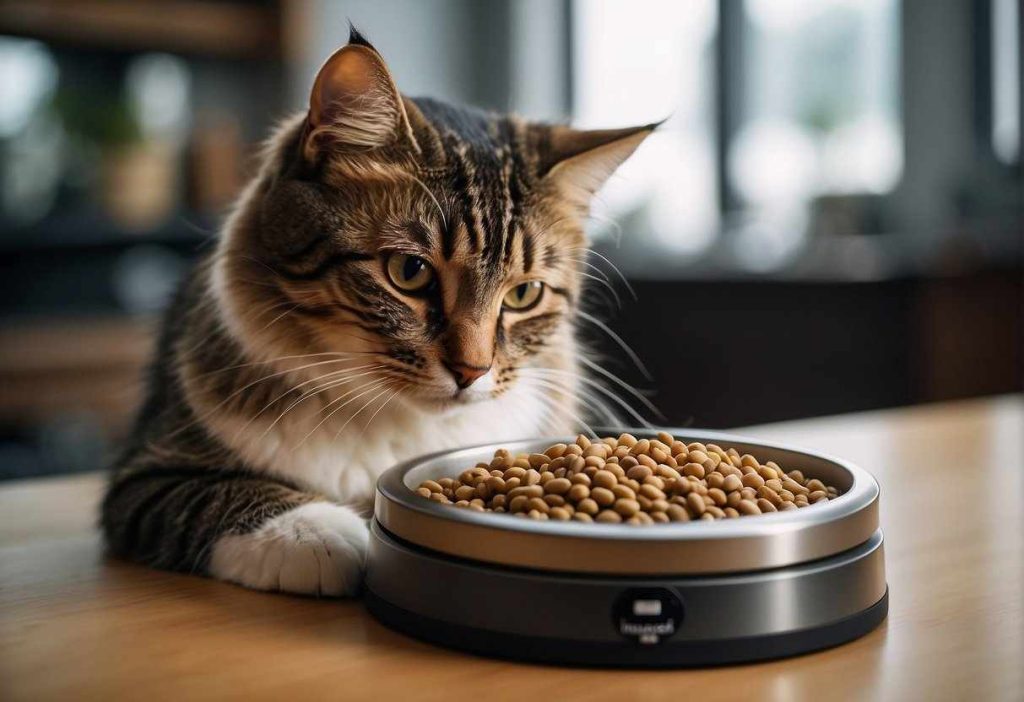
Benefits to Consider:
- Convenience: You’re off the hook from daily feeding duties.
- Portion Control: Helps maintain your cat’s healthy weight.
- Regular Feeding Schedule: Your buddy won’t miss a meal.
- Multiple Pets: You can manage the feeding of more than one pet.
Things to Keep in Mind:
- Power Source: Batteries or electricity?
- Food Type Compatibility: Dry, wet, or both?
- Quantity Control: How much can it dispense at a time?
- Ease of Cleaning: Is it dishwasher-safe?
Did You Know?
A whopping 58% of cats in the US are overweight or obese. An automatic feeder can curb overfeeding and help with weight management.
Still mulling it over? Picture this: you’re at work, and your phone notifies you that your cat just had her lunch, hassle-free, thanks to your new gadget. Pretty neat, right? (7)
To wrap up, here’s a quick comparison to help you make the choice:
| Consideration | Benefit |
|---|---|
| Food Security | Ensures meals even when you’re away |
| Health Management | Prevents overfeeding, promotes good health |
| Time Management | Saves time, perfect for tight schedules |
| Satisfaction | Happier, well-fed pets and less stress for you |
Remember, a happy cat means a happy home, so weigh these points carefully when picking the perfect feeder. After all, your whiskered pal’s well-being is the ultimate goal.
Frequently Asked Questions
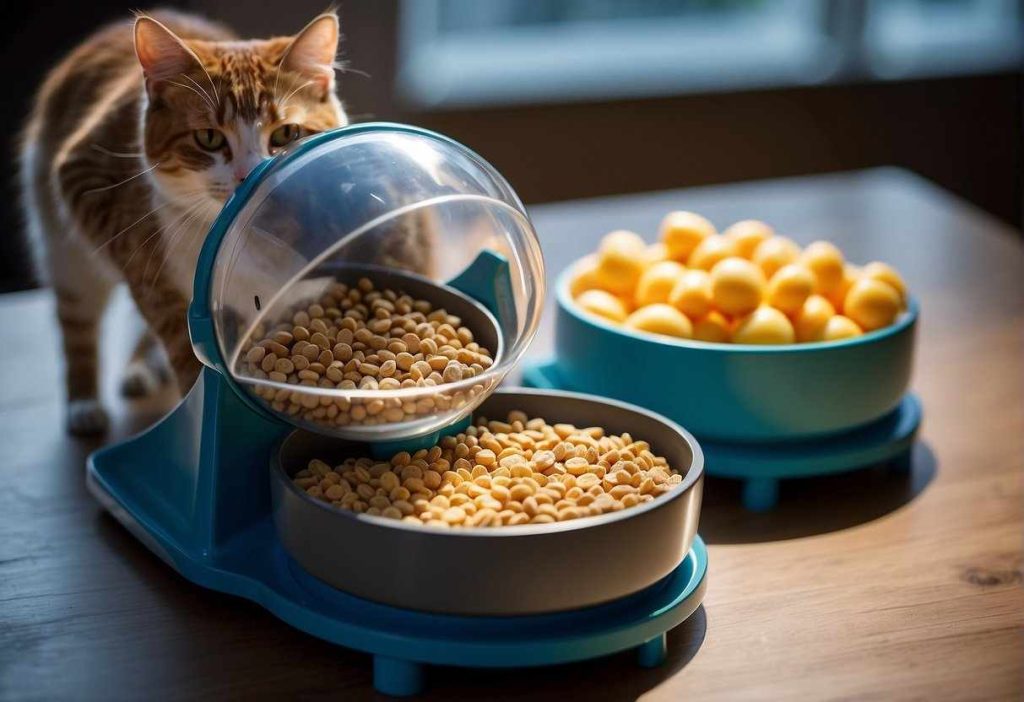
Here are some answers to the most common inquiries cat parents have about these handy devices.
How do I set up my automatic cat feeder for the first time?
First things first, give your new gadget a thorough inspection. Find a spot near a power outlet if it’s electric, or check that the batteries are fresh if it’s battery-operated.
Follow the specific instructions to load food and program meal times – usually, this involves a series of button presses or a smartphone app.
Make sure you do a few test runs to confirm everything’s dispensing correctly!
Can using an automatic feeder improve the well-being of my cat?
Absolutely! Automatic feeders can help maintain a regular feeding schedule, and that consistency is key for your cat’s digestive health and happiness.
Plus, it avoids overfeeding, which keeps your cat in tip-top shape.
How frequently should an automatic cat feeder be cleaned to ensure hygiene?
Keep it squeaky clean by washing the food bowl and hopper at least once a week, and wiping down the rest of the feeder.
If your model handles wet food, you’ll want to clean it more often to prevent bacterial growth.
What’s the longest time I can safely leave my cat with an automatic feeder?
If your feeder is full and functioning properly, leaving your cat alone for a weekend is generally fine.
However, cats need more than just food—don’t forget about water, a clean litter box, and some TLC!
Can automatic cat feeders dispense both dry and wet food?
Many models are designed for dry food, but there are feeders out there that can handle wet food too. Check the product specifications to be sure.
How do automatic feeders ensure my cat is eating the right amount?
Most automatic cat feeders come with portion control settings.
You’ll program the feeder to dispense just the amount your vet recommends for your cat’s age, size, and health.
Can one automatic feeder serve multiple cats?
Yes, there are models designed with multiple dishes or adjustable settings for several cats.
However, you might need separate feeders if your cats tend to squabble or need different diets.
- The Ultimate Overview to Actual Cash Gambling Establishments - July 1, 2025

